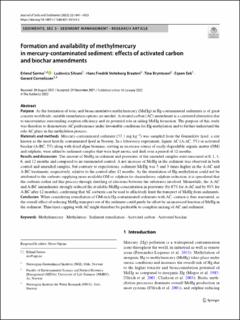| dc.description.abstract | Purpose As the formation of toxic and bioaccumulative methylmercury (MeHg) in Hg-contaminated sediments is of great concern worldwide, suitable remediation options are needed. Activated carbon (AC) amendment is a contested alternative due to uncertainties surrounding sorption efficiency and its potential role in aiding MeHg formation. The purpose of this study was therefore to demonstrate AC performance under favourable conditions for Hg-methylation and to further understand the role AC plays in the methylation process. Materials and methods Mercury-contaminated sediment (57.1 mg kg−1) was sampled from the Gunneklev fjord, a site known as the most heavily contaminated fjord in Norway. In a laboratory experiment, lignite AC (A-AC, 5%) or activated biochar (A-BC, 5%) along with dried algae biomass, serving as an excess source of easily degradable organic matter (OM) and sulphate, were added to sediment samples that were kept anoxic and dark over a period of 12 months. Results and discussion The amount of MeHg in sediment and porewater of the amended samples were measured at 0, 1, 3, 6, and 12 months and compared to an unamended control. A net increase of MeHg in the sediment was observed in both control and amended samples, but contrary to expectations, sediment MeHg was 5 and 3 times higher in the A-AC and A-BC treatments, respectively, relative to the control after 12 months. As the stimulation of Hg-methylation could not be attributed to the sorbents supplying more available OM or sulphate for dissimilatory sulphate reduction, it is speculated that the sorbents rather aid this process through shuttling of electrons between the substrates involved. Meanwhile, the A-AC and A-BC amendments strongly reduced the available MeHg-concentration in porewater (by 87% for A-AC and by 93% for A-BC after 12 months), confirming that AC sorbents can be used to effectively limit the transport of MeHg from sediments. Conclusion When considering remediation of OM-rich Hg-contaminated sediments with AC, caution is thus warranted, as the overall effect of reducing MeHg-transport out of the sediment could partly be offset by an increased fraction of MeHg in the sediment. Thin-layer capping with AC might therefore be preferable to complete mixing of AC and sediment. | |
